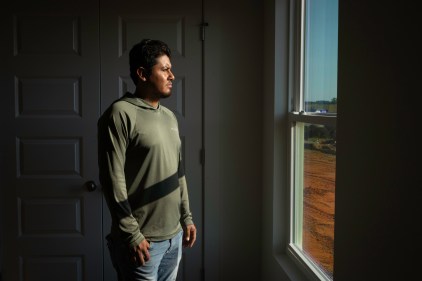Despite the blaring siren from a security guard’s phone, Rogelio Ramon was still half asleep just after 6 on a January morning, sitting where he’d slept on a red chair in an East Flatbush, Brooklyn, church. Across from him in the crowded sanctuary, a half-dozen West African men recited the Quran on the chancel and a man from China talked with a woman on WhatsApp. Ramon, who is from Venezuela, put on the snug-fitting winter parka he’d found in a donation bin and walked out into the biting cold to figure out where to pass the day. It would be nearly 14 hours until another church, an hour and a half away by subway in Harlem, would take him in.
Ramon had already spent a week crisscrossing the city in search of a safe place to lay his head. During his first month in New York he lived in a shelter, but he couldn’t stay. The city recently began limiting single adult migrants to a 30-day stay with an option to reapply for another 30 days, though the wait to get back in can be lengthy. New York hastily launched its new migrant reception system in the spring of 2022, and since then more than 170,000 people have passed through it. As with Ramon, some of them came on free buses from Texas, ending up in New York not because it was their chosen destination but because they had no other option. Many were part of Texas Gov. Greg Abbott’s initiative to funnel people entering the country into liberal cities and to export the stresses and tensions of the southern border into farflung parts of the country. New York is an attractive landing place because it is the only major U.S. city that’s required, pursuant to a four-decade-old consent decree, to provide a shelter to anyone in need.
But the arrival of more and more newcomers, often with no family or community waiting to absorb them, has taxed its shelter system, and it has forced a conflict over the future of the long-contested right-to-shelter rule, raising questions about how generous the city can and should be as migrants continue to arrive.
“The unfortunate reality is that we’ve been getting hundreds of people a day every day for nearly two years,” Kayla Mamelak, a spokesperson for Mayor Eric Adams, said. “We’re out of space and we’re out of money.” Officials recently estimated that the arrival of migrants will cost the city more than $10 billion over three years, and Adams has repeatedly called on the state and federal government to send more aid. The 30-day limits on an initial stay (60 days for families) have been a “success story,” Mamelak says, as a way to “nudge people into the next phase of their journey.” She said that only about a quarter of people who reach the shelter limit end up reapplying. “The goal is always self-sufficiency.”

But immigration and housing advocates say the system has left people waiting in untenable conditions for a new bed.
“The city is using the 30-day-limit and the reticketing process to make people miserable and hope they go away,” said Kathryn Kliff, an attorney with the Legal Aid Society’s Homeless Rights Project, which is in mediation with the city over the shelter requirement. Kliff acknowledges that the spike in recent arrivals has created new challenges for the city. But in years of city efforts to modify the requirements of the consent decree, single adults have never before been subjected to 30-day limits or left to wait for days on end in chairs or church pews to be assigned another bed. According to the city, the average wait time for single adults to be reassigned a shelter bed is eight days. Some wait weeks.
New York City has taken measures to limit the number of people who end up sleeping on the streets and in trains while they wait for a bed, subcontracting a handful of churches and mosques to provide floor space or a pew to hundreds of people each night. Ramon slept in four different houses of worship, scattered on the edges of the vast city. He says that because he now spends his days waiting to be told where he can sleep that night, looking for food and riding the train from one church to another, he hasn’t had time to find work. “I can’t get a job because I have to go to the place to find out where to sleep,” Ramon said of his daily cycle. “You can’t get out of it.”
Ramon had arrived at the U.S.-Mexico border in early December. His niece and her children, who’d crossed with him into El Paso, Texas, took a bus to Chicago, where they had a friend. Ramon told border authorities that he, too, would be going to Chicago, and they assigned him a court date there in September. But the only free bus he was able to board in Texas was to New York. The city has offered to pay the costs to transport migrants elsewhere. But Ramon has come to realize that Chicago might be worse. “I can’t get to Chicago because I wouldn’t have a place to live there,” Ramon said. “Here at least there’s something.”
To reapply for a stay in a shelter, migrants travel to a city building in Manhattan’s East Village. The processing center issues each person a number that’s written on a wristband. When their number comes up, they’re supposed to get a bed. One night during a snowstorm, soon after he’d reached the 30-day limit, Ramon tried to sneak back into the shelter after a fight at a church left him rattled. But, he says, the shelter told him that he had to leave. Ramon tipped over an orange road construction drum and pushed his long, skinny torso in as far as he could. He stayed there until morning.
On his fourth night out of the shelter, Ramon left the processing center carrying a small drawstring bag packed with a blanket, an extra T-shirt, a toothbrush and a worn manila envelope of immigration papers. Though he knew the next church wouldn’t accept anyone until 8 p.m., he didn’t know what else to do after riding the train aimlessly for hours, so he tried the church anyway. He plodded along the snowy sidewalk, climbed up a flight of stone church stairs and peered through the padlocked metal gate into a row of cloisters. Nobody was there or at the next gate that led into an old cemetery. He decided to ride the train for a few more hours.
Ramon returned just before 8 p.m. Behind him in line, a Guinean man named Omar who’d spent 30 days in shelter and 11 nights in churches and mosques, said in French: “We don’t really bathe. We get to these churches at 8 p.m. and we stay until 6 a.m. when they kick us out, and we don’t wash.” A 64-year-old Peruvian man said sleeping on the hard floor made his back hurt but was better than sleeping on the train or on the street, which he’d done for several nights. Ramon found a spot on the floor and lay on the blue blanket that a man at the Randall’s Island shelter had given him a few weeks before.


In the morning, after the church turned the lights on and as he prepared to leave again, Ramon met another Venezuelan man, a 46-year-old former customs officer named Giovanni Larez, who seemed to have a handle on how to get food and find a place to shower.
The two men left the church before sunrise. Ramon followed Larez to the Port Authority bus terminal, where Larez had learned they could wash in a bathroom. They sat on the floor against the wall in the terminal for an hour until an officer started telling others sitting nearby to leave, so they rode the train downtown to the city’s processing center in the East Village. The worker gave them the address of a different church, the one in East Flatbush. They walked in circles and then rode the train for several more hours until they arrived at the new church.
Larez, who has braces from the days when he had money and time for an orthodontist, showed me a video of himself riding on top of a Mexican freight train, passing through the desert on his way north, and a photo of his hands and knees covered in bandages from when he jumped off a train to run from Mexican authorities who chased him and others off the trains. “This is not the hardest thing I’ve been through,” he said of his shuffle through the shelters and churches. He explained that he expects to be able to pay rent soon, when it warms up and he can get some real employment (he worked two days clearing debris on a construction site but hasn’t found anything since). He also said he plans to get through his court date in June and then move to Phoenix with a work permit.

On a Sunday morning, the two men rode the train to a corner in central Brooklyn where someone from a church drops a bag of sandwiches on the sidewalk every afternoon. Then they went in search of the next church where they’d sleep.
The following Wednesday afternoon, the men returned to the East Village processing center. The city had still not reached the numbers written on their wristbands. They stood in the rain in the park with a hundred or so other men and women, many wearing cheap plastic ponchos they’d gotten inside. Someone from a nearby bakery delivered a paper bag of end-of-the-day baguettes and other baked goods. Men bounded toward the bag and took what they could. As they did, the bag broke, wet from the rain, and cookies and pastries fell to the ground. The men backed up, most returning to the lampposts and trees they rested on. And then, one after another stepped forward to pick up the cookies from the ground.

By Thursday, Ramon and Larez’s numbers had reached the front of the queue, but they were told there were no available shelter beds. They came back the next day and were told the same thing. They went back to the corner for sandwiches and then to a church to sleep. They came back to the processing center on Saturday and Sunday and were again told there were no beds. Though city officials say that wait times for adult men seeking readmission to shelters for migrants averaged around eight days, it had already been 13 days for Ramon and 12 for Larez.
On Sunday afternoon, nine days after they started traveling the city together, Ramon and Larez got separated on the train. Larez looked for Ramon at the East Village center but didn’t find him. “I guess he decided to go his own way,” Larez said.

Three days later, the city’s processing center finally assigned Ramon a new bed for 30 more days. He put his winter coat back on and rode the train to a shelter.

















